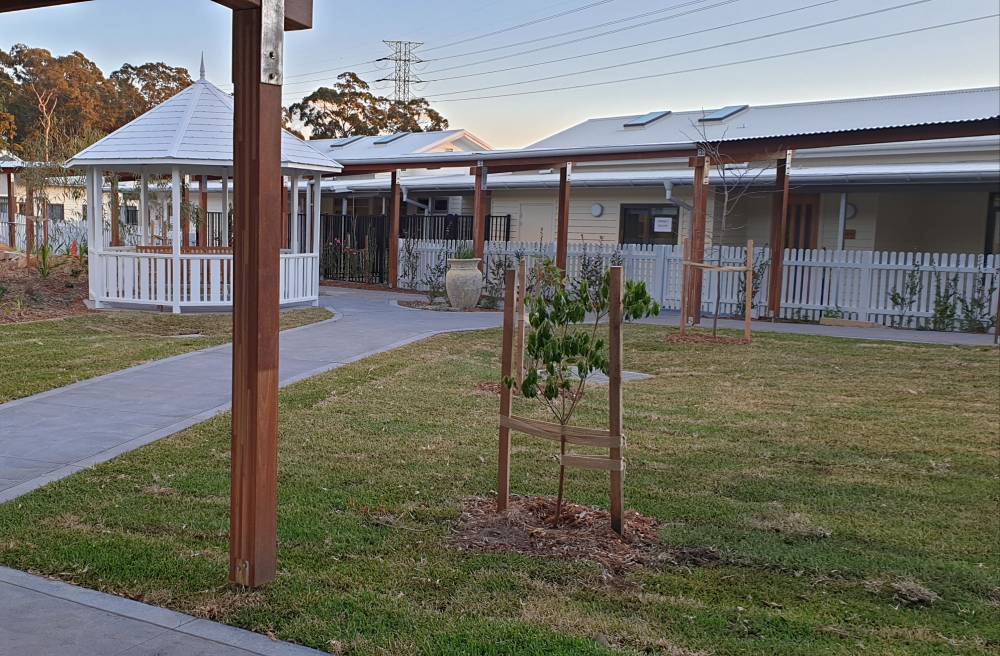
The Dutch concept of the dementia village, where residents live in small ‘cluster’ homes and continue to live as close to a ‘regular’ a life as possible, is now well established in Australia, with several built and operating, and more being built around the country.
In Cardiff, New South Wales, HammondCare has opened its latest village, its third to open this year.
At the Cardiff village, small homes are clustered around open spaces where people can meet and congregate. The village includes amenities that are familiar to all – a shop, café, hairdresser, and an open park area.

“The individual cottages and apartments are arranged around these communal spaces very much like a village and neighbourhood,” HammondCare’s General Manager of Residential Care, Angela Raguz, told HelloCare.
The spaces are “familiar, safe and accessible” so people with dementia and their friends and family can enjoy the kind of social interactions they might have enjoyed previously, but that might have become too difficult to take part in as their condition progresses.
Because the design of the village is much like a regular neighbourhood or town, it’s easy for residents to navigate.
Ms Raguz said every aspect of the homes is designed to benefit people living with dementia.
Key features of the homes making them suitable for those living with dementia include:
Good visual access around the cottage and village allow residents to see or sense where they want to go.
“The coffee shop is visually accessible from the front door of each house, and kitchen windows look out across community spaces,” Ms Raguz said.
“This is a unique and intentional component of our village design.”
“The key idea is that people do not want to live in institutions as they age, but rather in small domestic and familiar homes where autonomy and control are the focus,” Ms Raguz said.

Residents will be encouraged to remain involved with regular daily activities such as cooking, laundry and cleaning.
“There are fully functioning domestic kitchens in each house where all meals are prepared and where people can raid the fridge whenever they are hungry!” Ms Raguz said.
Laundry is done using regular domestic facilities, rather than institutional machines.
Of course, dementia villages are not just about the design. The care residents receive is also tailored to suit people living with dementia.
Because of the village-style accommodation, staff care for fewer residents, and it’s easier for them to get to know each resident and better understand their needs.
“The cottage approach means care staff can get to know the smaller number of people they care for and so are empowered to provide quality care,” Ms Raguz said.
Research has shown ‘clustered’ homes are associated with residents having a better quality of life and fewer hospital visits without increasing the cost of care to providers.
Ms Raguz said the suitability of village-style housing for people living with dementia has been known about for more than 20 years, and HammondCare been building them for decades.

“HammondCare has been passionate about this approach to dementia design for more than 20 years,” Ms Raguz said. “We built our first cottages for dementia care in Hammondville (south west Sydney) in the 1990s.”
In this year alone, HammondCare has opened village-style dementia homes in Caulfield, Hammondville and Cardiff, and the organisation hopes to build more in the future.
The Cardiff facility will eventually be home for up to 99 residents. The village has three nine-bed cottages, two 11-bed cottages, two 10 bed apartment buildings, and two buildings with 15 beds. Each resident will have their own room with ensuite. Residents will begin moving in in the coming weeks.
“We look forward to more and more dementia care homes that respect the evidence and build environments for people with dementia that put them first, rather than other considerations,” Ms Raguz said.
HammondCare has a long history of providing care and services for people who are financially disadvantaged.
It will “continue to do so” at the Cardiff home, Ms Raguz said.
In 2020, HammondCare plans to open an aged care home for people who are homeless or at risk of homelessness.
Ms Raguz said, “While it is not specifically for people with dementia, it will draw on the same principles – small, domestic, familiar.”
Read about the University of Queensland research that says smaller aged care homes deliver higher quality of care.
Could partners of dementia resident also live in the village. Would be interested to know.
Hi Carol, thanks for your question. You can speak to staff at HammondCare Cardiff directly via links on this webpage – they’ll be able to answer this and any other questions you may have. https://www.hammond.com.au/cardiff#tour-form
Thanks. I hope you’re able to expand this concept for dementia care into many more areas in Australia. My partner is living with dementia in a nursing home. She is well looked after but very lonely. Do you have any plans to create village style facilities in the Nowra. NSW. region?